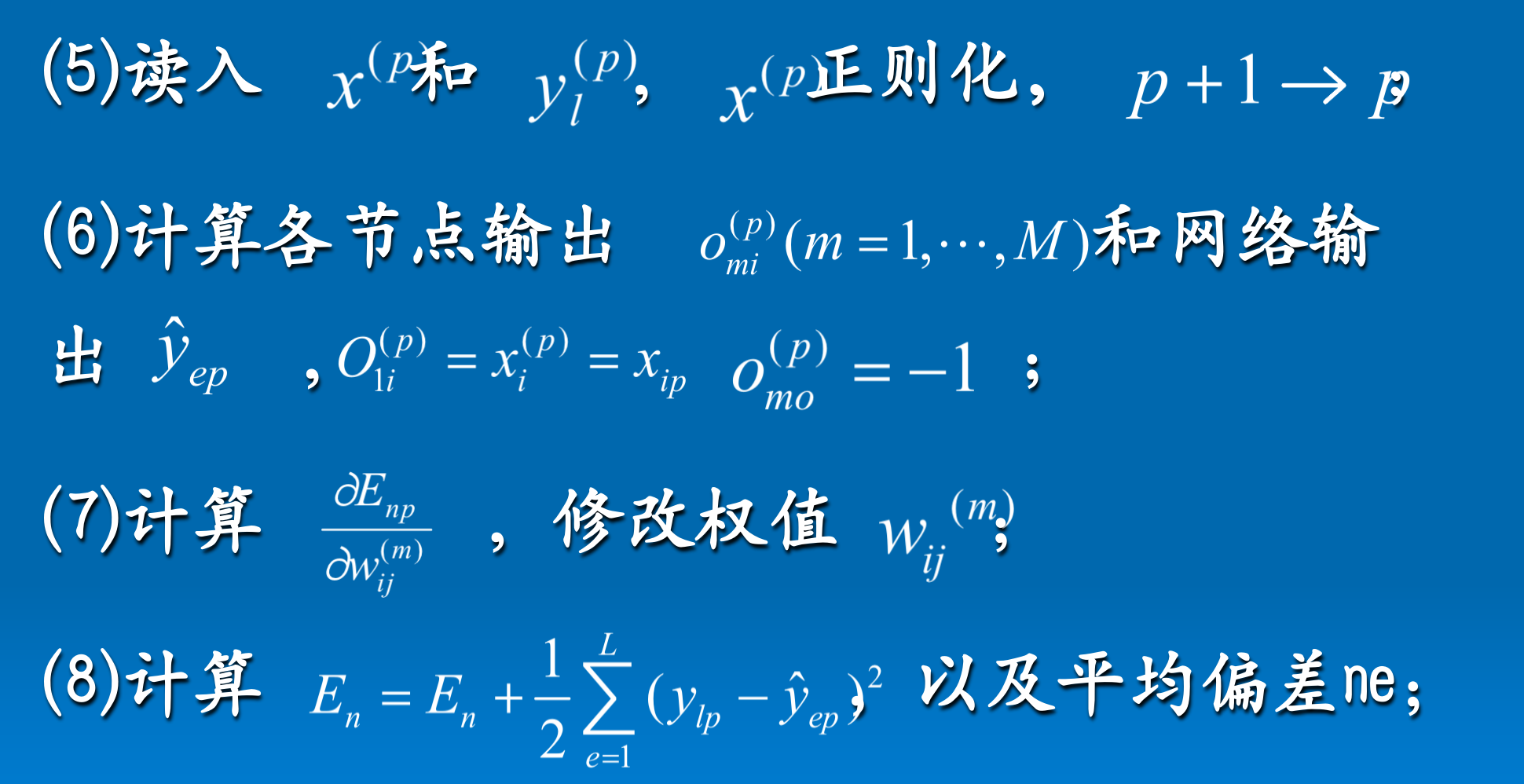Article catalog
BP
- For the input signal, it should first propagate forward to the hidden layer, and then propagate the output information of the hidden neuron to the output neuron after passing through the action function, and finally output the result.
- BP network application
- Function approximation: train a network with input vector and corresponding output vector to approximate a function;
- Pattern recognition: use a specific output vector to associate it with the input vector
- Classification: classify the input vectors in a defined and appropriate way;
- Data compression: reduce the dimension of output vector to facilitate transmission or storage
- Requirements for BP action function:
- It must be differentiable everywhere, and the binary threshold function {0,1} or symbolic function {- 1, + 1} cannot be used;
- BP uses S-type function or hyperbolic tangent function or linear function
- S-type function has the function of nonlinear amplification coefficient. It can transform the input signal from negative infinity to positive infinity into 0 to 1 (or - 1 to l)
- For the larger input signal, the method coefficient is smaller; For smaller input signals, the amplification factor is larger. The nonlinear input-output relationship can be processed and approximated by using S-type activation function
- In the first case, the hidden layer adopts S-type action function, while the output layer adopts linear action function
- The more hidden layers, the higher the accuracy of the network, but it will affect its generalization ability
BP algorithm steps
(1) Initialization: \ ETA, \ alpha, pass = 0, Max, me; (2) All weights and neural threshold W are randomly given in the range of [- 0.3,0.3]_ {ij} ^ {(n)} assigns an initial value (3) Judge whether the connection weights of the input terminals of each neuron from layer 2 to layer M of the section meet: Yes turn (4), otherwise reduce to know whether they meet; (4)P = 0,E_{n},pass+1=pass


numpy reproduction
- Title: suppose 7 short segments are used to form a total of 10 digital graphics, so that the 7 segments are represented by a vector [b_1,b_2,b_3,b_4,b_5,b_6,b_7]. For the segments used in the digital graphics, the corresponding component value is 1, and the corresponding component value of the unused segments is 0. Therefore, each digital graphics can be represented by a vector, and its sequence number is 1,2,..., 10, Try to design a neural network, which can distinguish odd numbers from even numbers.
The X matrix is: x = [[1,1,0,0,0,0,0,0], [0,1,1,0,1,1,1], [0,0,1,1,1,1], [1,0,1,1,1,1,1], [1,0,0,1,1,1], [1,1,0,1,1,1], [0,1,1,1,0,0], [1,1,1,1,1,1,1], [1,0,1,1,1,1] The Y tag feature is Y=[1,0,1,0,1,0,1,0,1]
# -*- coding:utf-8 -*-
# /usr/bin/python
import numpy as np
import math
class BP():
def __init__(self,hidden_n,output_n,learningrate,epoch):
'''BP parameter'''
self.hidden_n = hidden_n
self.output_n = output_n
self.hideWeight = None
self.outputWeight = None
self.learningrate = learningrate
self.inputN = None
self.hideOutput = None
self.output = None
self.loss= None
self.epoch = epoch
self.limitloss = 0.01
def initWeight(self,n, m,fill=0.0):
'''Initialization weight'''
mat = []
for i in range(m):
mat.append([fill] * n)
mat = np.array(mat)
mat = mat.transpose()
return mat
def sigmoid(self,x):
'''sigmoid Activation function'''
return 1.0 / (1.0 + np.exp(-x))
def linear(self,x):
'''Linear action function'''
return x
def sigmoidDerivative(self,x):
'''Derived sigmoid'''
return x-x**2
def initBp(self,inputN):
'''initialization BP'''
self.inputN=inputN+1
self.hideOutput = self.hidden_n+1
#init weight
self.hideWeight = self.initWeight(self.inputN,self.hidden_n+1)
self.outputWeight = self.initWeight(self.hidden_n+1,self.output_n)
def forwardPropagation(self,X):
'''Forward propagation'''
self.hideOutput = self.sigmoid(np.dot(X,self.hideWeight))
# self.hideOutput = np.c_[self.hideOutput, np.ones(self.hideOutput.shape[0])]# Add a column for bias
self.output = self.sigmoid(np.dot(self.hideOutput, self.outputWeight))
def lossFun(self,Y):
'''loss function '''
self.loss = 0.5*np.sum((Y - self.output) * (Y - self.output))
return self.loss
def backPropagation(self,X,Y):
self.outputWeight = self.outputWeight.transpose()
outputWeightbiassum= 0
for i in range(self.output_n):
outputWeightbias = self.learningrate * (self.output[i] - Y[i]) * self.sigmoidDerivative(self.output[i]) * self.hideOutput
self.outputWeight[i,:] += outputWeightbias
outputWeightbiassum -= outputWeightbias
self.outputWeight = self.outputWeight.transpose()
self.hideWeight = self.hideWeight.transpose()
for i in range(self.hidden_n+1):
hideWeightbias = self.learningrate*outputWeightbias[i]*self.sigmoidDerivative(self.hideOutput[i])*X
self.hideWeight[i, :] -= hideWeightbias
self.hideWeight = self.hideWeight.transpose()
def train(self,X,Y):
'''train'''
inputN = X.shape[1]
samplesN= X.shape[0]
X = np.c_[X,np.ones(samplesN)] # Add a column for bias
self.initBp(inputN)
for i in range(self.epoch):
for one in range(samplesN):
x,y = X[one,:],Y[one,:]
self.forwardPropagation(x)
loss = self.lossFun(y)
if loss<= self.limitloss:
break
else:
self.backPropagation(x,y)
i +=1
def predict(self,X):
'''forecast'''
samplesN = X.shape[0]
X = np.c_[X, np.ones(samplesN)] # Add a column for bias
for one in range(samplesN):
x= X[one, :]
self.forwardPropagation(x)
print(self.output)
X=[[1,1,0,0,0,0,0],[0,1,1,0,1,1,1],[0,0,1,1,1,1,1],[1,0,1,1,0,1,0],[1,0,0,1,1,1,1],[1,1,0,1,1,1,1],[0,0,1,1,1,0,0],[1,1,1,1,1,1,1],[1,0,1,1,1,1,1]]
Y=[[1],[0],[1],[0],[1],[0],[1],[0],[1]]
xtest = [[1,1,0,0,0,0,0],[0,1,1,0,1,1,1]]
print(X,"\n",Y)
XTrain = np.array(X)
YTrain = np.array(Y)
xtest = np.array(xtest)
print(XTrain.shape[1])
print(XTrain)
hidden_n,output_n,learningrate,epoch = 3,1,0.5,1000
newbp = BP(hidden_n,output_n,learningrate,epoch)
newbp.train(XTrain,YTrain)
newbp.predict(xtest)